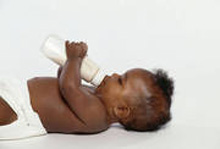New Studies Reveal Toxic Rocket Fuel Chemical
in Baby Formula and Drinking Water
by www.SixWise.com
Perchlorate, a chemical used in rocket fuel, explosives, and fireworks, has been found in public drinking water supplies and some foods, including baby formula.
|

Detectable levels of perchlorate were found in every infant formula tested.
|
Exposure to the chemical is known to disrupt thyroid function, a gland that plays an important role in metabolism and produces hormones that help regulate heart rate, blood pressure, body temperature and the rate at which food is converted into energy.
In fetuses and infants, thyroid hormones are essential for normal growth and development of the central nervous system. Even a small drop in thyroid function in infants can lead to loss of IQ or increases in behavioral and perception problems.
Further, perchlorate can interfere with your body’s ability to absorb iodine into the thyroid, which is critical for normal production of thyroid hormone.
In a new study by researchers from the U.S. Centers for Disease Control and Prevention (CDC), traces of perchlorate were found in samples of powdered baby formula. The amounts detected could exceed what’s considered a safe dose for adults if mixed with perchlorate-contaminated tap water.
The chemical was found in every sample tested, with formulas derived from cow’s milk containing the highest levels.
"Infants fed cow's milk-based powdered formula could be exposed to perchlorate from two sources -- tap water and formula," Anila Jacob, a senior scientist with the Environmental Working Group, told the New York Times. "That suggests that millions of American babies are potentially at risk."
To date, perchlorate has been found in the drinking water of at least 35 states and the District of Columbia.
There are Currently No Limits on Perchlorate in Tap Water
A document from the U.S. Environmental Protection Agency (EPA) estimated that up to 16.6 million Americans are exposed to unsafe levels of perchloate, while data from independent researchers suggests 20 million to 40 million may be at risk, the Washington Post reported.
Despite its known presence in tap water supplies, and its potential danger to humans, particularly pregnant women, fetuses and newborns, in 2008 the EPA decided NOT to regulate perchlorate in water, saying it would offer no "meaningful opportunity for health risk reduction."
While some perchlorate occurs naturally, most contamination in U.S. drinking water can be traced back to improper disposal by rocket test sites, military bases and chemical plants, and nationwide cleanup would likely amount to hundreds of millions, or even billions, of dollars.
According to a report by the Washington Post, the EPA’s proposal to regulate the chemical listed a maximum allowable level that was 15 times higher than EPA scientists had suggested in 2002, and was “heavily edited by officials of the White House Office of Management and Budget (OMB).” Not only were key passages eliminated, but OMB asked the EPA to use a new approach to calculate perchlorate’s risks.
|

Filtering your water using reverse osmosis technology, combined with the Wellness Kitchen Water Filter system , can help remove perchlorate and other dangerous contaminants from your tap water.
|
"They have distorted the science to such an extent that they can justify not regulating" the chemical, said Robert Zoeller, a University of Massachusetts professor who specializes in thyroid hormone and brain development, in the Washington Post. "Infants and children will continue to be damaged, and that damage is significant."
In the EPA’s proposed rule, exposure to perchlorate contamination of 15 ppb is deemed safe, however regulatory documents say "between 16,000 and 28,000 pregnant women" and 900,000 to 2 million Americans could be exposed to higher levels.
Further, the EPA document shows that bottle-fed infants would be exposed to perchlorate at levels more than five times those the National Academy of Sciences said were safe if they drank formula mixed with water containing perchlorate levels of 15 ppb.
Fortunately, in January 2009 the EPA decided to delay their final decision on perchlorate regulation, or lack thereof, until the National Academy of Sciences looks into the matter.
What Can You do to Reduce Your Exposure in the Meantime?
If you have a baby, breastfeeding rather than using formula is the healthiest choice. However, if you’re unable to breastfeed, make sure your tap water does not contain additional perchlorate. There are a couple of ways to do this:
-
Call your drinking water utility or state drinking water program to find out the results of past perchlorate monitoring or to find out if monitoring is required in your state.
-
If there is no requirement for monitoring in your state, you can have your water analyzed by a laboratory that is certified for the analysis of perchlorate or similar compounds.
If you find that your water is contaminated with perchlorate, or if you simply want to be on the safe side (while removing the many other potentially dangerous chemicals in tap water), you should filter your water. This is important not only for the water given to infants and children, but for all the water used in your home.
Reverse osmosis technology has been certified by NSF International (the National Sanitation Foundation) to remove perchlorate from levels as high as 130 µg/L to 4 µg/L or less in drinking water, according to the EPA. However, the Agency still recommends that you contact the manufacturer to determine if the unit can indeed remove perchlorate from your water supply before opting to install a reverse osmosis system in your home.
Reverse Osmosis May Not be Enough to Get High-Quality Water for Your Family
A reverse osmosis (RO) filter is necessary if you live in an area with perchlorate contamination, and also if you need to remove extreme levels of TDS (Total Dissolved Solids), sediments, salts or sulfates due to local water issues.
However, you should note that RO systems have many downsides that make them less than ideal as a universal solution to water treatment. Most notably, they remove everything from your water, including healthy and stabilizing minerals such as calcium, magnesium, potassium, silica and others.
Further, RO systems have high waste (75% of water is wasted on average) and low output (typically only 10-15 gallons per DAY). These, coupled with extensive maintenance requirements, make them less than desirable for many families.
For these reasons, we suggest RO systems be used only as necessary due to local water issues, such as perchlorate or the other unique situations mentioned above.
In these cases, it is ideal to connect a highly recommended Wellness Kitchen Water Filter system after the RO system. It will not completely re-mineralize your water, but it will add some minerals back in and provide better chemical reduction than RO systems can provide alone.
Filtering your water to remove perchlorate and other chemicals is so simple, yet it can have a far-reaching impact on your family’s health and well-being. So whether you use RO technology, a Wellness Kitchen system or a combination of the two, make sure you are taking this important step to ensure the safety and quality of your drinking water.
Recommended Reading
Four Common but Toxic Chemicals to Avoid During Pregnancy, Pre-Pregnancy and Breastfeeding
What's Really in Bottled Water? New Study Reveals the Disturbing Truth
Sources
Journal of Exposure Science and Environmental Epidemiology March 18, 2009
U.S. EPA Drinking Water Contaminants, Perchlorate
U.S. FDA Perchlorate Questions and Answers
NYTimes.com April 3, 2009
Yahoo Health April 3, 2009
WashingtonPost.com September 22, 2008